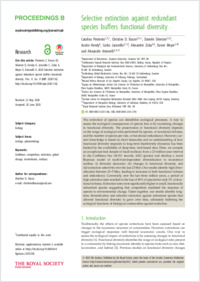Selective extinction against redundant species buffers functional diversity
- Pimiento, Catalina Department of Biosciences, Swansea University, Swansea SA2 8PP, UK - Smithsonian Tropical Research Institute, Box 0843-03092, Balboa, Ancon, Republic of Panama
- Bacon, Christine D. Department of Biological and Environmental Sciences, University of Gothenburg, Box 461, SE-405 30 Gothenburg, Sweden - Gothenburg Global Biodiversity Centre, Box 461, SE-405 30 Gothenburg, Sweden
- Silvestro, Daniele Department of Biological and Environmental Sciences, University of Gothenburg, Box 461, SE-405 30 Gothenburg, Sweden - Gothenburg Global Biodiversity Centre, Box 461, SE-405 30 Gothenburg, Sweden - Department of Biology, University of Fribourg, Fribourg, Switzerland
- Hendy, Austin Natural History Museum of Los Angeles County, Los Angeles, CA 90007, USA
- Jaramillo, Carlos Smithsonian Tropical Research Institute, Box 0843-03092, Balboa, Ancon, Republic of Panama - Equipe de Paléontologie, Institut des Sciences de l’Évolution de Montpellier, University of Montpellier, Place Eugène Bataillon, 34095 Montpellier Cedex 05, France - Institut des Sciences de l’Évolution de Montpellier, University of Montpellier, Place Eugène Bataillon, 34095 Montpellier Cedex 05, France
- Zizka, Alexander Gothenburg Global Biodiversity Centre, Box 461, SE-405 30 Gothenburg, Sweden - German Center for Integrative Biodiversity Research (i, Div) Halle Jena Leipzig, 04103 Leipzig, Germany
- Meyer, Xavier Department of Biology, University of Fribourg, Fribourg, Switzerland - Department of Integrative Biology, University of California, Berkeley, CA 94720, USA
- Antonelli, Alexandre Department of Biological and Environmental Sciences, University of Gothenburg, Box 461, SE-405 30 Gothenburg, Sweden - Gothenburg Global Biodiversity Centre, Box 461, SE-405 30 Gothenburg, Sweden - Royal Botanical Gardens Kew, Richmond TW9 3AE, UK
-
29.07.2020
Published in:
- Proceedings of the Royal Society B: Biological Sciences. - 2020, vol. 287, no. 2020-1931, p. 20201162
English
The extinction of species can destabilize ecological processes. A way to assess the ecological consequences of species loss is by examining changes in functional diversity. The preservation of functional diversity depends on the range of ecological roles performed by species, or functional richness, and the number of species per role, or functional redundancy. However, current knowledge is based on short timescales and an understanding of how functional diversity responds to long-term biodiversity dynamics has been limited by the availability of deep-time, trait-based data. Here, we compile an exceptional trait dataset of fossil molluscs from a 23- million-year interval in the Caribbean Sea (34 011 records, 4422 species) and develop a novel Bayesian model of multi-trait-dependent diversification to reconstruct mollusc (i) diversity dynamics, (ii) changes in functional diversity, and (iii) extinction selectivity over the last 23 Myr. Our results identify high diversification between 23–5 Mya, leading to increases in both functional richness and redundancy. Conversely, over the last three million years, a period of high extinction rates resulted in the loss of 49% of species but only 3% of functional richness. Extinction rates were significantly higher in small, functionally redundant species suggesting that competition mediated the response of species to environmental change. Taken together, our results identify long-term diversification and selective extinction against redundant species that allowed functional diversity to grow over time, ultimately buffering the ecological functions of biological communities against extinction.
- Faculty
- Faculté des sciences et de médecine
- Department
- Département de Biologie
- Language
-
- English
- Classification
- Biological sciences
- License
-
License undefined
- Identifiers
-
- RERO DOC 328903
- DOI 10.1098/rspb.2020.1162
- DOI 10.6084/m9.figshare.c.5053398.v2
- Persistent URL
- https://folia.unifr.ch/unifr/documents/309023
Statistics
Document views: 152
File downloads:
- pdf: 161
